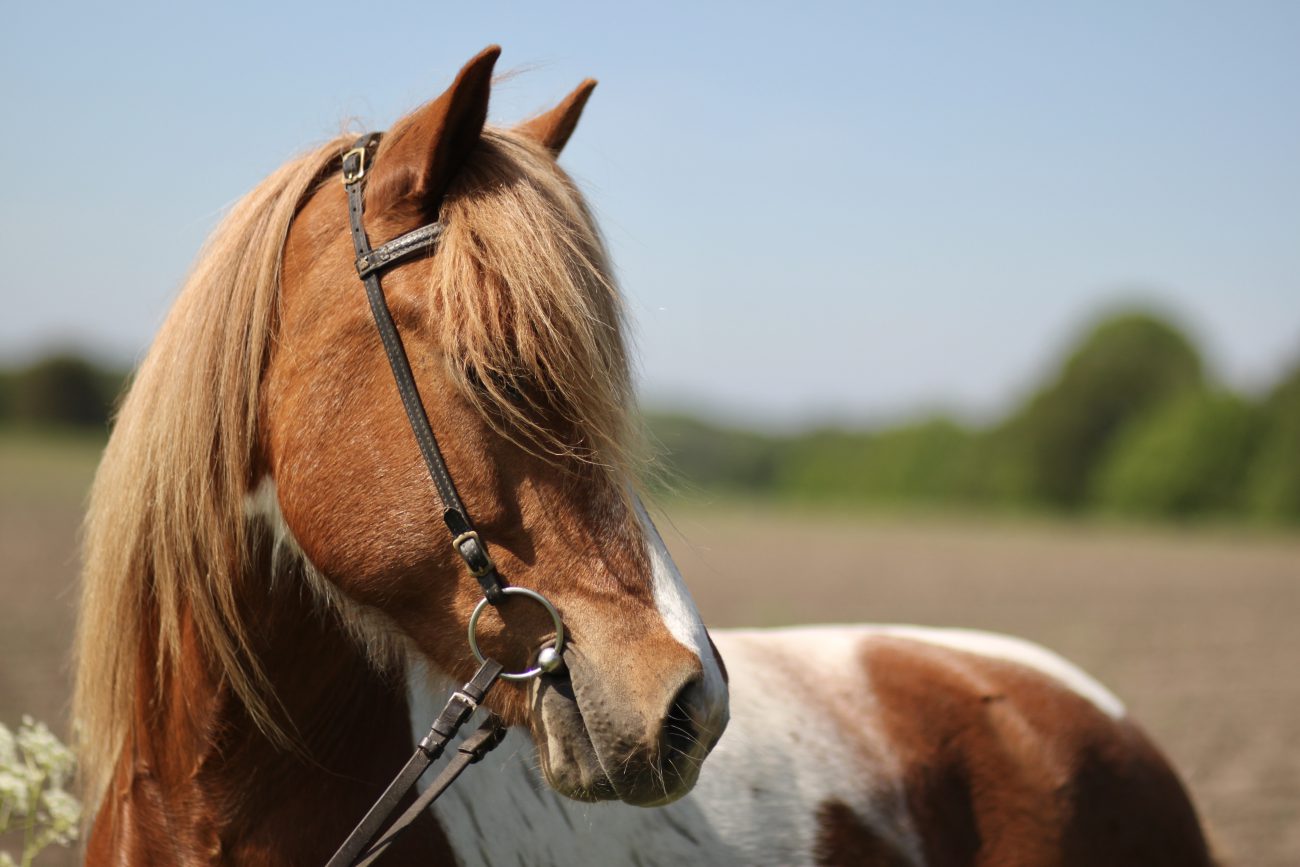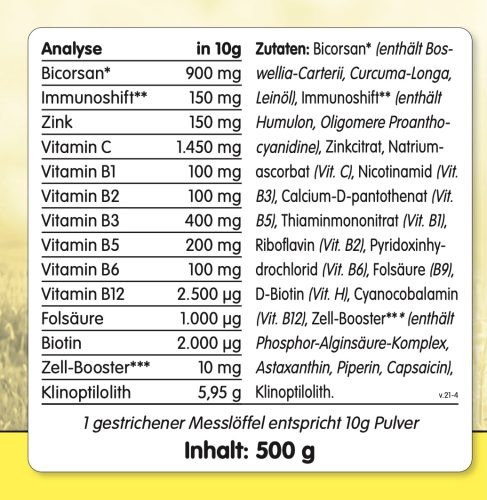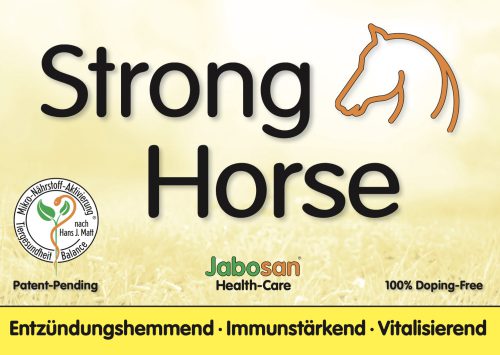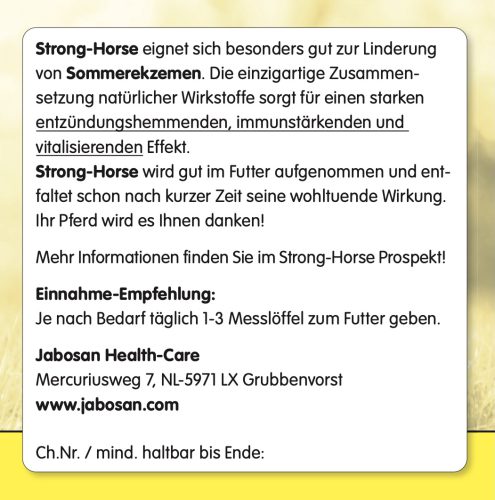Summer eczema & the help from nature
NEW DEVELOPMENT
Strong-Horse is a special product that has been used with great success in the treatment of summer eczema.
The Manufacturing Process of “Micro-Nutrient Activation” guarantees high bioavailability. Successful application observations were already carried out with the new development Strong Horse in the summer of 2020/21.
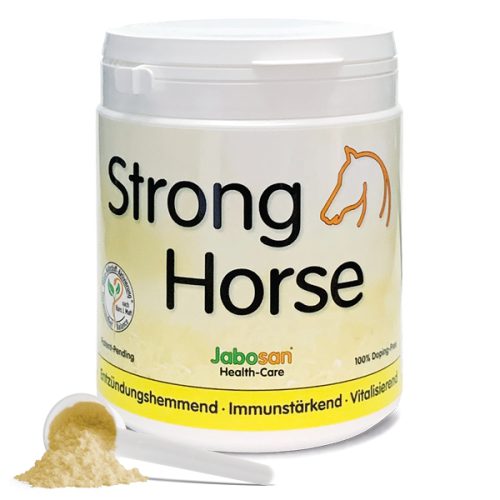
About sweet itch:
Summer eczema is a spectrum of allergic skin symptoms that are not solely, but mainly based on a type I allergy. These are triggered or maintained by insects, above all the black fly. It is therefore primarily a type I allergic insect dermatitis. In our latitudes, imported horses in particular are exposed to insects that do not exist in the country of origin. Therefore, they react even more often with an allergic reaction to the stings. House, stable and pasture flies do not usually cause summer eczema, but they can keep it up because they feed on wound exudate or suck blood in open areas. Sometimes this leads to further infections.
Sweet itch usually appears from the age of 3 and gets worse in the 4th-6th year. A weaker expression is found in the first symptomatic year. Affected horses often remain allergic for life. It can only sometimes regress in old age. Infectious diseases often lead to the onset of eczema. Icelandic horses often bring along a genetic predisposition to eczema. Some of them show liver weakness or a general metabolic strain. One reason for this is the protein-rich gras, which is hardly available in the natural habitat of the animals. Toxic stress can also lead to an increase in symptoms. A zinc deficiency should be checked on heavily grazed areas. Manganese, chromium, and biotin are also important for keeping the skin healthy and for a balanced immune system.
Noticeable and a first sign is intensive rubbing on the head area. Further on, bald spots to weeping skin changes appear on various parts of the body. Especially for Icelandic horses, the mane area is most commonly affected. Here, chafing causes hair breakage and mostly pronounced crust formation. A distinction is made between early eczema (from May) and late eczema (from August).
Decisive for allergies to occur is an overreactive side of the humoral immune system. Observational studies from the human and animal sectors indicate that humulones and oligomeric proanthocyanidins can balance the immune system in synergy with other substances.
Study results also show the anti-inflammatory effects of frankincense, turmeric and linseed oil, which are used in the product “Strong Horse” in the case of eczema. Thanks to the micronutrient activation process, the ingredients are particularly bioavailable for the horse’s body.
Also included are:
- A combination of vital substances (e.g. zinc, folic acid, B vitamins, biotin, vitamin C),
- a cell booster for better oxygen supply to the cell (alginic acid complex),
- clinoptilolite for detoxification and
- toxin binding as well as immunoshift.
These natural substances can be classified in the group of TNF-alpha inhibitors (inflammation inhibitors).
Strong-Horse is a special product that has been used with great success in the treatment of summer eczema.
The Manufacturing Process of “Micro-Nutrient Activation” guarantees high bioavailability. Successful application observations were already carried out with the new development Strong Horse in the summer of 2020/21.
Intake recommendation:
Depending on the severity of sweet itch and weight, add 1 – 3 measuring spoons to the feed daily.
Ingestion Duration:
Depending on the problem, we recommend the continuous use of Strong-Horse from April to October. As a preventive treatment, 2-3 months in spring are sufficient. Sufficient for 4-6 weeks
Free hotline and order: info@jabosan.com
Telephone: 0031-77-327 00 33 / 0800-122 10 99 (free of charge)
Technical questions to: info@therapiekonzepte.com
Product Link: https://www.jabosan.com/strong-horse-dose-a-500-gramm.html
*Ad
A land of fire and ice, with more sheep than inhabitants, characterized by a unique nature! This is just a brief description of such a diverse country. While a volcano may erupt on one side of the country, you can hike a glacier, admire the Northern Lights, or take a bath in a hot spring on the other side of the country - at the same time.
This not only speaks for diversity, but also for spontaneity, which is also reflected in the changeable weather in Iceland. A popular Icelandic saying is "If you do not like the current weather, just wait for five minutes".
In contrast to this inconsistency, one thing is constant and that is the enthusiasm for Icelandic horses! The Vikings brought horses to the island in the 9th century.
To find out more about Iceland, you can find travelogues, reports, or interesting facts here in the UNDRA Journal!
